#pro biodiversity
Text
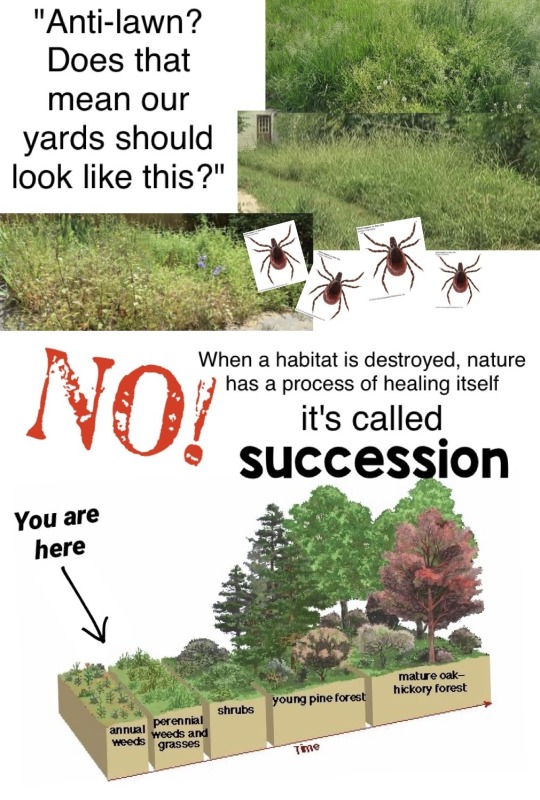
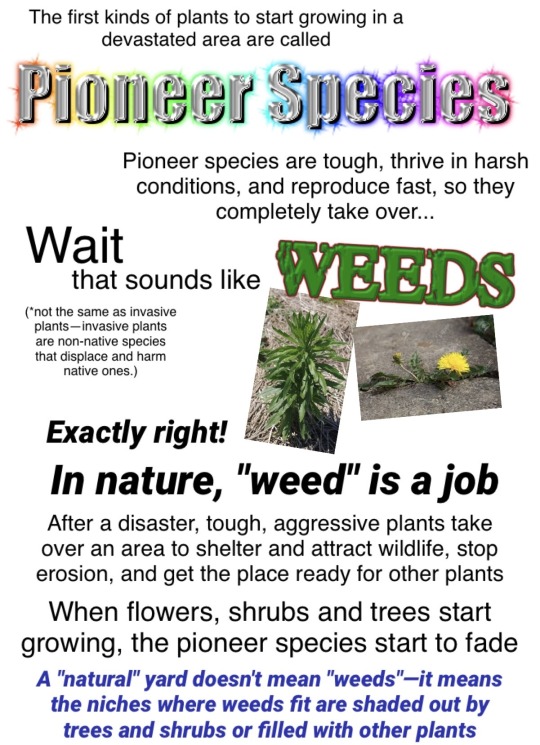
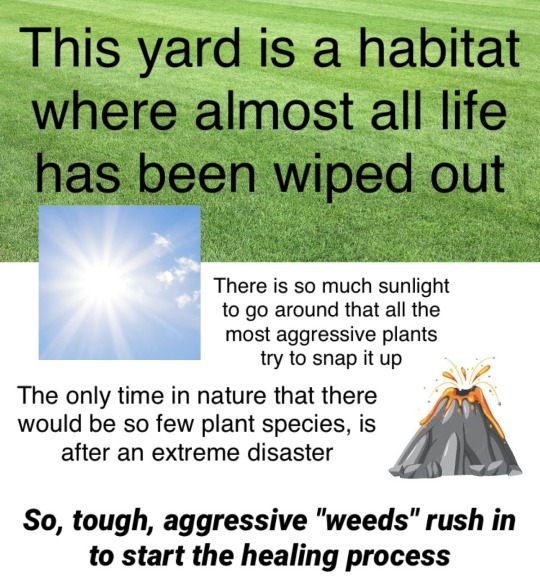
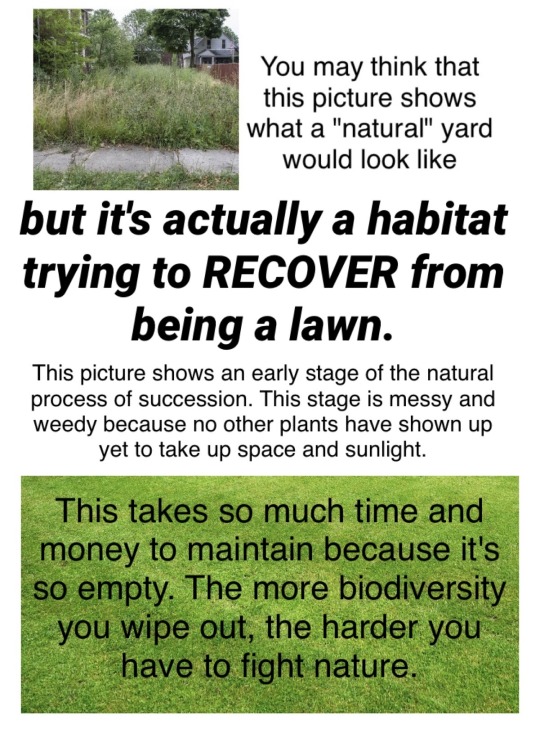

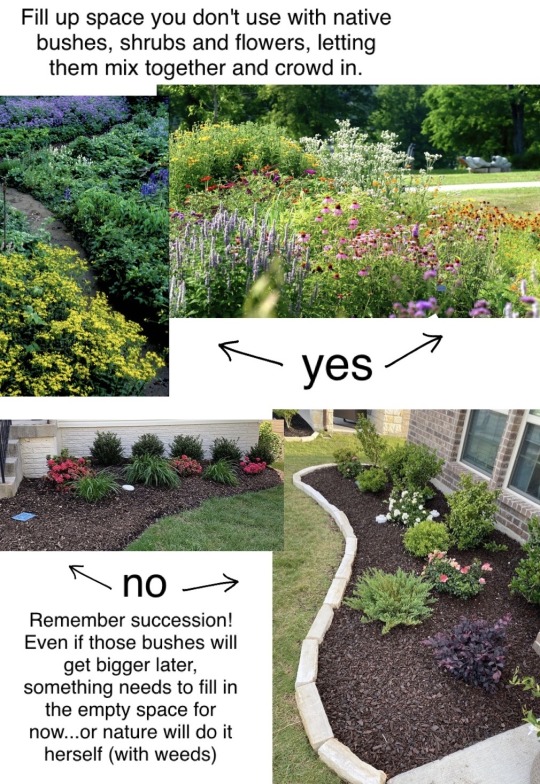
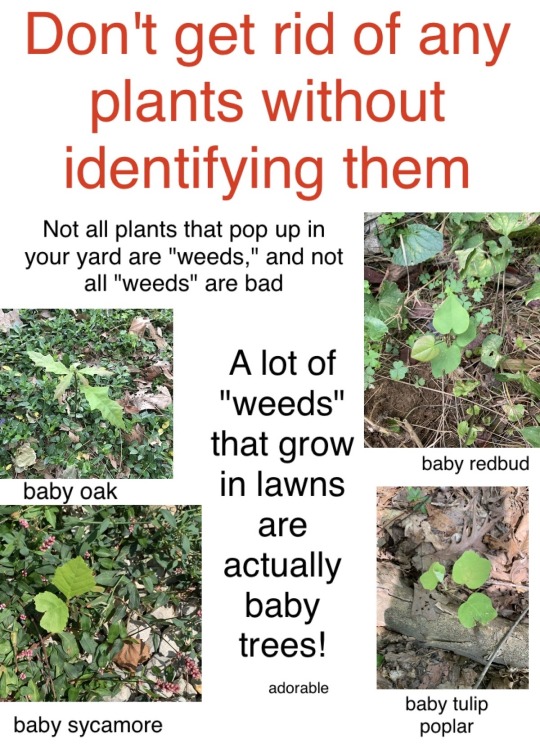
I...tried to make a meme and got carried away and made A Thing that is like partially unfinished because i spent like 3 hours on it and then got tired.
I think this is mostly scientifically accurate but truth be told, there seems to be relatively little research on succession in regards to lawns specifically (as opposed to like, pastures). I am not exaggerating how bad they are for biodiversity though—recent research has referred to them as "ecological deserts."
Feel free to repost, no need for credit
#random#ecology#shitpost#sorta#gardening#plants#lawn alternatives#anti lawn#pro biodiversity#biodiversity win#bugs tw#ticks
180K notes
·
View notes
Text
Just drove through Helena, Montana and I highly recommend the shop Montana Book Co. They have zines, queer literature, books on ecology and climate change, books from indie authors, books from authors of color, pro-choice pins, magnets from that guy who makes the “I’ll sell you for corn chip” bird art, a ton of fancy markers and art stuff, etc etc. I bought my first pronoun pin. It gave me a real “safe hub for queer, neurodivergent, etc kids” vibe

image: a bookshop with a sign that says Montana Book Co. There are pride flags and BLM signs in the windows. End description.
#Bookblr#zines#Queer#biodiversity#bookstore#pro choice#women’s rights#trans rights#idk if they do online sales but I would order from them#Indie stores
45 notes
·
View notes
Text
you can make posts that are anti lawns and pro biodiversity without downplaying the real, terrible danger that ticks pose
#I am begging you learn about lyme and then do everything you can to avoid it#lyme disease#ticks#mine.
33K notes
·
View notes
Text
i love tumblr cause every now and then discourse from a really niche community will just seep into my feed with absolutely no context
#i just saw a post about how anti-lawn and pro-biodiversity tumblr is apparently forgetting ticks are a thing#i've been on this website ten fucking years and i didn't even know that anti-lawn/pro-biodiversity was a position one could have
1 note
·
View note
Note
When horses end up with severe leg/hip injuries, they are almost always put to sleep. The odds of recovering full mobility from such injuries are slim and the odds of reinjury are high, so even if the horse is perfectly healthy in all other aspects, it is generally recognized to be more humane to put them down than to keep them alive just to live the rest of their lives limping around a small paddock or stall. A life for a horse in which s/he cannot gallop, leap, explore and play is no life at all. Why not apply the same logic to cetaceans? A life for a cetacean in which they can’t dive hundreds of meters, make meaningful autonomous choices (“should I play with the rubber ball or the puzzle feeder today?” is not a meaningful choice; research has shown that autonomy is crucial for animal welfare), echolocate and experience the rich biodiversity of the ocean is no life. I really don’t understand why it’s so horrible to think it more humane to euthanize a confused and sick orca calf if there is no chance of rehab and release than to take her/him permanently into captivity. It’s not disparaging or hateful to cetacean trainers to say so—I know they care about animals—it’s simply a logical ethical stance. Instead of searching in vain for orca conservation organizations that aren’t “radically anti-captivity”, maybe pro-caps should look inwards and ask themselves why all the major orca organizations (Center for Whale Research, Orca Behavior Institute, OrcaLab, Wild Orca, Orca Conservancy, Far East Russia Orca Project, etc.) as well as some cetacean organizations (ex. Whale and Dolphin Conservation, Cetacean Society International) oppose captivity. Is it because all of these esteemed groups, which if you look them up are all staffed by credentialed scientists, have been duped by the “animal rights agenda”, or could it be because maybe, just maybe, they know what they’re talking about? If captive orcas are so different from wild ones that wild orca biologists have no credibility to speak about their welfare, then that’s a clear indictment of captivity already.
Hi. I'm sorry for not answering right away, I was still at my externship when I got your ask, and I wanted to be able to sit down and give you a proper answer. So unfortunately, I don't think what I say will satisfy you. I don't expect to change your mind, nor is that my goal here. I only want to explain why I believe the way I do, so that you or others reading this can at least understand that it's not a position I take lightly, nor do I think it's infallible.
(Long post below the cut):
To start off, as an (almost) veterinarian, there are absolutely plenty of circumstances where I find euthanasia to be the correct decision. Euthanasia is our final gift to our patients, a swift and painless death in the face of prolonged suffering or poor quality of life. A large dog with debilitating osteoarthritis. A cat with terminal lymphoma. A down cow. A raptor with an amputated leg. Or like you mentioned, a horse with a fractured hip. These animals would live in a constant state of pain that they don't understand, and death can rightly be considered a kindness to them.
But an otherwise healthy orca calf? I would consider that a false equivalence. I agree that life in the wild should be prioritized whenever possible, and that captive orcas lead very different lives than their wild counterparts. But if that orca cannot return to the wild (orphaned and unable to be reunited with its pod, habituated to humans, non-painful disability such as deafness), and there is a facility willing to take it on, I do not think euthanasia is an appropriate option. In human care, that calf can still swim, breach, and dive, even if not to the same depths as the ocean (it's also worth noting that these are all costly behavior energetically and are not performed for no reason). It can still socialize and form family bonds with an adopted pod of whales. It can still (theoretically) mate and rear calves. It can still engage its big brain in problem-solving through training and enrichment in the place of hunting. And as a bonus, it will never go hungry and has access to veterinary care if ill or injured.
This is not a wild life. This is not the same life they would've, or should've known. A pool, no matter how well-appointed, is not the ocean, and we should not claim they're comparable. But I don't think it's a fate worse than death. I truly don't. But if it is... if freedom really is worth more than life, then all captive whales need to be euthanized. Even in a sea pen setting, they will not be free. They will not choose their food, their companions, their enrichment, their comings and goings. Those choices will still be made on their behalf by caregivers, and they will still have pretty much the same levels of autonomy as in their tank habitat. They will still be captive. (While some people do advocate for this, I don't think it's a popular outlook. Even SOS Dolfijn, a historically anti-cap organization, recently announced plans to build an aqauarium as a permanent home for non-releasable cetaceans rather than continuing to euthanize them).
Speaking of autonomy, yes, it is very important. But I truly don't think the orcas are distressed by the lack of meaning in choosing between enrichment devices. I think that's why we disagree on this topic... we have different worldviews. We both see orcas as beautiful, intelligent creatures, but I do not see them as people. They are animals, and for all their complexity, I interpret their behavior the same way I do any other species... they are motivated by food, reproduction, and (since they're highly social) companionship. Because of that, I still think we can give them a good life in human care, which is why it frustrates me to see the zoo community throw up their hands and give up rather than trying to improve our current less-than-ideal setups (*shakes my fist at the Blue World project*).
Now, I don't think it's wrong to be emotional about animals. I most definitely am! And it's very clear to me you love orcas and care about their wellbeing deeply. I admire that about you, and I appreciate your passion.
On to the next point... in the cetacean world, I've found that there is an unfortunate divide between researchers and caregivers who work with cetaceans in human care and those who study them exclusively in the wild. And that schism far predates the Blackfish era. Most of those organizations you listed are indeed legitimate, and I fully support their vital work and encourage others to do the same. A few of them, though, share things like this:

I think you can understand why this hurts me. And it's a lie. I've now interned at three aquariums (two of them AZA-accredited) that house various species of cetacean, and it's impossible for me to reconcile what I know and have seen to be true and what Whale and Dolphin Conservation wants the public to believe: that these unbelievably loved, vivacious animals are drugged and tortured by their greedy captors. It's not true, and I do not appreciate WDC for spreading this creepy artwork around. Nor do I think that fighting captivity is a beneficial allocation of resources when there is an overwhelming number of genuine threats to the survival of wild cetaceans.
Anyway, back to the scientists. Personally, I don't consider researchers who work exclusively with wild orcas to be either superior or inferior to those who work with captive whales. And sometimes I wonder how much of their position is a self-fulfilling prophecy: if someone opposes captivity on moral grounds, they won't work with captive whales, so they'll never get to know what their lives and care are like beyond maybe a single tour of the park or memories of how things were done in the 1960s (like Dr. Spong, who worked with some of the very first captive orcas at the Vancouver Aquarium).
I also don't think it diminishes the expertise of wildlife biologists to say that they are not experts on husbandry, training, or medical care... those are very different fields, and ideally, they should all inform each other. And of course, there are folks who work with both wild and captive whales. One of the reasons I linked SR3 in my previous post is they have staff with backgrounds in both managed care and research of free-ranging populations (I actually have no idea what the organization's official stance on captivity is, it's not something they address).
Maybe I'm wrong. I try my best to keep an open mind, but I know I'm also swayed by my own preconceptions and experiences. When I started this blog in December 2020, I was a first year vet student with minimal actual experience outside of domestic animals and some herps, and had only recently adopted the pro-captivity outlook. Now, I'm much more deeply involved in the zoo and aquarium world. These are people I know and respect, people who have written me letters of recommendation and comment on my Facebook posts, people I've had dinner with and showed up with after hours to care for a sick animal. And I recognize that biases me. The zoo world is often resistant to change, especially folks who have been in the industry for many years. And that doesn't do anyone, especially the animals, any good. I don't want to get stuck in an echo chamber, so I make it a point to read anti-captivity literature, even when it upsets me. If there is anything I can do to improve their lives, I want to learn about it, regardless of the source.
I try to adapt to new information. For example, in the past few months alone, I've become a lot more favorable toward the idea of sea pen habitats. My concerns about "sanctuaries" are more logisitical* and philosophical** rather than the idea that artifical habitats are inherently superior to pen habitats (they're not), especially when plenty of traditional facilites already make great use of ocean pens or enclosed lagoons. There are pros and cons to both, and a lot of it depends on the needs of the individual animals.
*funding; maintenance; lack of land-based backup pools and fully-equipped medical facilities; introducing immunologically naive animals to pollutants and infectious agents; disruptions to native wildlife; staffing activists and wildlife biologists rather than those with relevant husbandry experience
**villainizing aquariums; promoting the project as a "release to freedom" to the public when it's really another form of captivity; claiming the animals' lives will be "natural" when they will still require training, artificial enrichment, contraceptives, and social management if done correctly; downplaying or completely denying the very real risks of such a transition and insisting the animals will automatically be better off when Little White and Little Grey have proved that's not the case
If you made it to the bottom, thanks for reading. I wish all the best for you, and I mean that genuinely ❤️ even if we disagree, I hope you can appreciate our shared love for these animals and a desire for their wellbeing. Best of luck in all your endeavors!
#also no hard feelings if you unfollow me#I understand#orcas#killer whales#dolphins#cetaceans#marine mammals#animal welfare#cetacean captivity#pro captivity#anti captivity#aquariums#answered asks#anonymous
147 notes
·
View notes
Text
The Scouring of the Shire and its aftermath is not simply pro-tree—it’s pro-stewardship and anti-pollution. The shadow of defeat touches every front. There are, right now, people on our Earth fighting Big Oil and Big Pipeline on the largest global stages, but there also people in their hometowns resisting the latest attempt to revive an incinerator, expand a cancer-causing plastics plant, or run a liquefied natural gas train through the center of it all. Pro-tree, anti-pollution—it’s all part and parcel of addressing the complex system of entanglements that is climate change, that is biodiversity loss, that is a long, sobering series of ecological disasters and defeats.
44 notes
·
View notes
Text
The Secret Other Thing: KILL
This is my eighth post in a series I’ll be making on how to increase biodiversity on a budget! I’m not an expert--just an enthusiast--but I hope something you find here helps!

KILL, TEAR, RIP, MAIM.
You may have seen this sentiment a few times on gardening and wildlife blogs and been incredibly confused. Isn’t killing things the opposite of what you should be doing to protect habitats? In some cases, it really is necessary!
Invasive Plants
Invasive plants can do more harm than good, taking up space and nutrients and providing little in return to local wildlife--while spreading and choking out the native plants that would provide the most to our native fauna. Learn how to identify invasive species in your area and how to properly dispose of them, and do so whenever you have the opportunity! You may even be able to find volunteer groups/events where you can join up with like-minded people to remove a specific plant from an area.

(This image refers to the United States specifically--these plants aren't invasive or native everywhere!)
Pro tip, though; if you take out an invasive species and leave empty soil where it was, it’s likely another quick-growing invasive species will just move in. We don’t want that! Try to plant something in its place! If you’re going out on a mission to take out invasive plants, try to keep some native flower seeds or seedlings on your person while you do this work.
Different plants are invasive in different places, so be sure that the plant you're targeting is actually invasive to where you are. You don’t want to rip out a beneficial plant because it’s invasive somewhere else! Social media sites like Instagram and Tumblr are great for spreading information about invasive plants, but they can often be a bit… US-centric. Even I'm guilty of this, plenty of times! Plants like garlic mustard, kudzu, butterfly bush, Amur honeysuckle, wild radish, and Japanese knotweed are high-profile invasive plants that I hear about all the time here in America--but they came from somewhere, and are a part of the environment in these places! Likewise, many plants that are branded as pollinator-friendly and biodiversity boosters here in the states can be awful invasive species elsewhere. Even plants and animals that aren’t invasive in one part of a country or continent can be detrimental in another--Canadian waterweed is native to North America, but it’s actually invasive in Alaska.



(Japanese honeysuckle (Lonicera japonica) vs Coral honeysuckle (Lonicera sempervirens) vs the yellow variety of Coral honeysuckle (Lonicera sempervirens))
Be sure you’re taking out the right plant--be very confident in your ID before you take any action! Amur honeysuckle and Japanese honeysuckle, for example, may be invasive in the US--but coral and northern bush honeysuckles are native and key species in their environments. You don’t want to do harm while trying to do good--double check your IDs. Being certain with your IDs can also prevent you from doing harm to yourself and others--some plants produce toxic smoke when burned. Stay well-read on how to dispose of the invasive plants you’re targeting.

(Garlic mustard pesto! Can't say I've ever had it, but I've heard good things about it online!)
With that being said! Some invasive species can be eaten. It’s free food! And you’re helping the environment? Win-win! Try looking up recipes that use these plants, or see how you can substitute something else for them! Foraging guides and blogs would likely be extremely helpful for this.
A super easy way to help curb the spread of invasive plants is to not grow them yourself! Double check any plant you’re considering buying or growing from seed--some sold in stores like butterfly bush are often touted as great plants to add to a pollinator garden, but in reality are an invasive species that eagerly displaces native shrubs here in the states.

POV: you're working the garden center at the Blue Big Box Store, you care about the environment, and every day you watch people buy Butterfly Bush and can do jack shit about it asides from try to gently steer them towards something else (but the other next best option was also Invasive Tropical Milkweed because its easier for Big Box Store to sell) I have a personal vendetta against people who grow Butterfly Bush (I live in The States) (If you didn't know Butterfly Bush was invasive in the US before now you're valid but also please god consider replacing it with an alternative ASAP)
Invasive Animals

POV 30 to 50 feral hogs are running into your yard within 3-5 minutes while your small children play
Invasive animals and insects compete for resources, take over habitat, and can even spread disease--all while pushing native species out or dwindling their numbers. Keep track of invasive animals you see and report them. Depending on the severity of the situation, killing them can be necessary and even encouraged. Do be sure it’s an invasive species and not a look-alike. If you’re unsure, take pictures, do research, and take action the next time.
Some high-profile invasive species in the US are spotted lanternflies, cuban tree frogs, hammerhead worms, feral swine, zebra mussels, lionfish, asian carp, burmese python, and others. Again, do make sure you’re targeting species that are invasive in your area; I doubt Asian carp are considered invasive in Asia, for example. Similarly, the American bullfrog is native to the eastern US and Canada, but is quickly becoming an invasive species around the rest of the world. Not to mention, the racoon problem in Japan…

Some invasive species can be eaten as well! Some of them taste awful, and some can even be dangerous to eat or handle without caution. I would do a good amount of research online before trying to cook up just anything.
Doing it Right
If you’re trying to handle invasive species, you do have to ensure you’re doing it properly. As you do your research, you’ll likely see if the species should be photographed and reported and to what channels. Also in some cases, going about destroying them incorrectly could unintentionally help them spread--some plants spread quickly through rhizomes into disturbed soil, and hammerhead worms can actually regenerate from pieces into fully-developed new worms when you try to cut them up. Some invasive species are even actively harmful to humans, so I cannot emphasize enough that you need to be sure about what you’re dealing with and be careful about it. Giant Hogweed, for example, has toxic sap that’ll cause severe skin inflammation and painful blisters if it contacts skin and is exposed to sunlight. The blisters last for months, and the skin may develop long-term sensitivity for sunlight.
If you’re unsure about how to handle an invasive plant, or are unsure of it’s identity, try contacting your local university co-op extension service if you’re in the states. They can tell you how to remove it safely and effectively. I can't say for sure what other channels would be the best option for someone living outside the states, so if anyone knows, feel free to chime in!
Pets
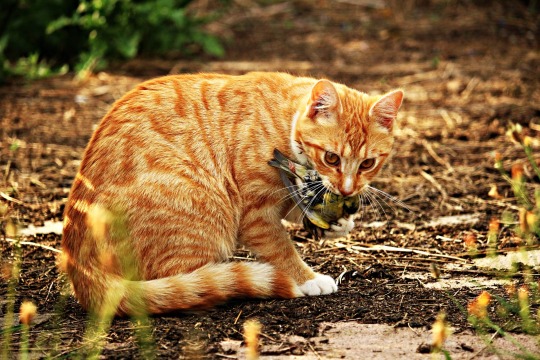
POV: ur little outdoor kitty Firestar is destroying the balance of your local ecosystem plz keep him INSIDE
Please keep your pets inside, or at least on a leash. An outdoor cat can do a lot more damage than one might imagine, as well as unrestrained dogs.
That’s the end of this post! And... technically, the last post in the series! My next and final final post is gonna be basically a giant list of all my sources that I used to make this post! I hope this post series was informative, helpful, interesting--anything of value, really! Feel free to reply with any questions, your success stories, or anything you think I may have forgotten to add in!
#biodiversity#solarpunk#gardening#invasive species#ani rambles#out of queue#the biodiversity saga#i wasn't sure where to add this in on the post but not all non natives are invasive and some native plants have sorta invasive-y habits#i dont remember the proper term that isn't just 'invasive-y' but yknow.#with that being said I tend to do a quick google search to make sure a plant I wanna buy isn't invasive before I add it to my garden#with that being said fuck big box stores STOP SELLING INVASIVE PLANTS I SWEAR TO GOD I DONT CARE IF THEY'RE POPULAR STOP IT STOP IT STOP IT#someday I will go on an entire unhinged rant about tropical milkweed#ive already done it before but I'm willing to do it again fuck it#anyways!!!! this is the last post if you don't wanna read Collection Of Links: The Musical so uh#hope this was a nice series with helpful information!! love yall byeeee
58 notes
·
View notes
Text
Here, among these 8,000-year-old urban agricultural fields long referred to as the “lungs” (Kurmanji: lêdanê; Turkish: akciğer) that “breathe” (Turkish: nefes almak) life into the informal capital of southeastern Turkey’s Kurdistan, most farmers depend on chemical fertilizers and pesticides to cultivate corn and maize, the monocrops promoted by [...] landlords and the Turkish state.
The Gardens, which have one of the most biodiverse ecosystems in the Middle East, are home to rare bird, butterfly, and reptilian species and endemic plants. [...] [T]he plots were added to UNESCO’s List of World Heritage Sites in 2015 together with the ancient district of Sur, located in the buffer zone just inside the Diyarbakır Fortress walls. [...]
Together, they work to create a seed bank of pest-resistant plants native to Kurdistan. Azad stresses the difficulties of putting decolonial ecological principles into practice under the state’s brutal blockade where “war is the climate,” as people put it. Before the Siege of 2015–2016, hundreds of eco-projects were realized with non-hybrid seeds and pesticide-free farming by eco-activists and Yazidi refugee women who in 2014 fled the Yazidi Genocide in their ancestral homeland of Sinjar in Iraqi Kurdistan and settled in the refugee camp of Diyarbakır. Since the occupation of Sur and its surrounding areas, they are all largely ruined. [...]
---
Occupied ecologies are as much about destruction as they are about construction. [...] In 2015, the Turkish government had expedited an “emergency appropriation” of 60 percent of Sur properties. [...]
The removal of underground materials, the damming of rivers, the replacement of traditional crops with profit-yielding industrial commodities such as maize and cotton, the uprooting of ecological life, the decline of rare indigenous weasel and water turtle populations, and the ruined and resurgent ecologies these destructive processes have generated in and through war would be impossible without the wielding of specific forms of political violence upon the land to make it “available” for colonial development. [...] Coproducing infrastructure and ecology as possessions of the nation-state and as commodifiable resources meant the proliferation of these projects all over Kurdistan, to be constructed and managed by private companies. [...]
In 2005, the decolonial paradigm of self-governance became the Kurdish movement’s ecological model. [...] This “greening” of the larger Kurdish movement, organized in Turkish Kurdistan as ecology councils (Kurmanji: meclîsa ekolojî) under the Mesopotamian Ecology Movement spawned several campaigns: one against the militarization of the region via a new type of high-security police station, the kalekol; one against the extraction of shale gas by fracking; and one against the Tigris Valley Project development of the area directly across the Tigris River from the Hewsel Gardens. [...]
But by autumn 2016, the pro-Kurdish municipalities had been placed under Turkish trusteeship (Turkish: kayyum), and their democratically elected Kurdish mayors had been dismissed. The state then put an end to these activities, and, in an ironic twist, co-opted the city’s age-old idiom of “breath” as a way to greenwash the destructive effects of its campaign for “mobilizing saplings” (Turkish: fidan seferberliği) [...].
---
Text by: Umut Yildirim. “Resistant Roots: Occupied Ecologies on the Shores of the Tigris River.” Jadaliyaa. 21 March 2022. [Some paragraph breaks/contractions added by me.]
113 notes
·
View notes
Text
“Indigenous peoples are the rightful owners of many of the remaining spaces where biodiversity thrives, and as such we have much to contribute. Our efforts to protect nature should be supported. What’s more, Indigenous peoples have been serving humanity through their sustainable use of biodiversity for generations – pro bono and even, at times, at great peril to their lives.”
83 notes
·
View notes
Text
A history of the Jedi on Lothal, but it's framed as a report on Lothal's biodiversity and fauna and flora conservation programs and laws pre-empire, post-empire, and under Imperial rule.
Very pro-jedi.
How the Lothal Jedi helped both the citizens and farmers with conservation work and education, pre abandonment of the Lothal temple.
How the first of the loth-wolf conservation laws were drafted and the Jedi's legacy.
How Ezra and Jai and others like Zeb and Cal helped update the laws.
How the empire blatantly broke and weakened said laws and environmental regulations. How the farmers and other citizens before Palpatine took over slowly drove loth-wolves and other predator megafauna nearly to extinction and led to overpopulation of prey species.
Analysis of Lothal's prarie ecosystem. (Based off Texas Blackland prarie and the Great plains of the US and Canada)
9 notes
·
View notes
Text
Mom sent me a facebook link to a PBS news hour post about how the anti-lawn movement is growing. The vast majority of the comments on it were stuff like this:


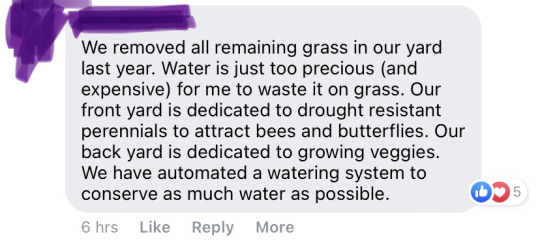
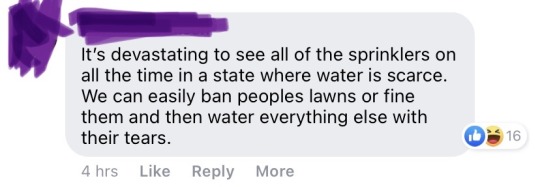
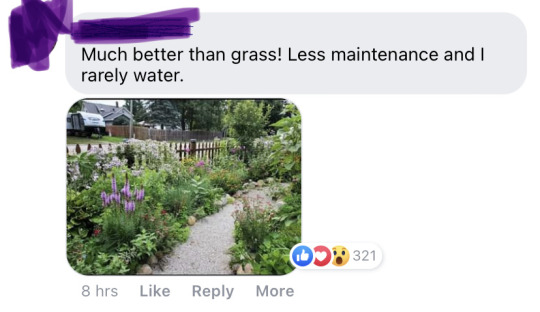


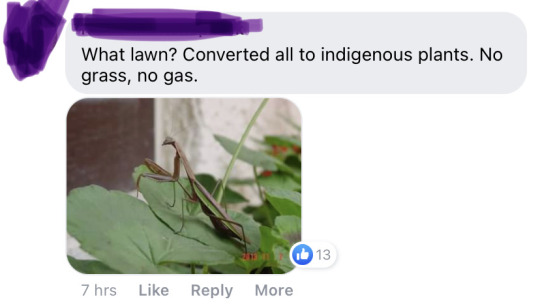
Most people are on our side here, even the so-called "boomers." We just have to be spreading ecological knowledge and practical means of creating useful habitat in back yards! Educate! Protect! Resist!
56K notes
·
View notes
Text
EU-Mercosur deal slowly vanishing

The European Union's Commissioner who was due to attend the Dec. 7 Mercosur Summit in Rio de Janeiro to sign the trade agreement between both blocs has canceled his trip, it was reported Sunday. According to the Financial Times, Valdis Dombrovskis shall not be attending the event, which in addition to announcements in Buenos Aires and Brasilia coupled with further negative statements from French President Emmanuel Macron, would amount to the end. at least for now, of the much-heralded agreement.
Lula and Macron met Saturday in Dubai but no progress was made. Brazil holds the pro tempore presidency of the South American alliance until Dec. 7.
Macron on Saturday spoke against the agreement due to its incompatibility with Brazil's environmental policy. The French leader said the agreement was “incoherent” and “badly patched up” because it “doesn't take into account biodiversity and the climate within it.” He added that it was “an old-fashioned trade agreement that undoes tariffs.”
Brazilian President Luiz Inácio Lula da Silva criticized France's “protectionism.” Lula also wants changes to the free trade agreement's points on government procurement bids, because, for him, it is a policy that induces the development of national industry and an opportunity for small and medium-sized companies.
Continue reading.
#brazil#brazilian politics#politics#europe#european union#european politics#luiz inacio lula da silva#emmanuel macron#international politics#economy#foreign policy#mercosur#mod nise da silveira#image description in alt
7 notes
·
View notes
Text
A list of inaccuracies about Costa Rica in the Jurassic Park movie franchise, from a Costa Rican who adores Jurassic Park:
Famously, the capital of Costa Rica--San José--isn't nowhere near the coast
Rancheras aren't blasted very often at restaurants either. Rancheras are more a Mexican tradition.
Costa Rica has a strict policy about protecting national parks. Our most famous island, which is pretty far away from the mainland, is Coco's Island. It's uninhabited except for the park rangers, no civilian visitors are ever allowed to protect the integrity of the island. The only way five islands that big remained uninhabited in Costa Rican territory is if they had been part of a national park, too. INGen wouldn't have been able to purchase the islands at all in the first place.
In that same vein, a possible solution, narrative-wise, would be for INGen to involve the government of Costa Rica from the get-go, and get special permission to develop a biodiversity protection program in the island as well as their own thing. Quid pro quo. This sounds way more plausible than Costa Rica just selling WHOLE islands to some gringos (Costa Rica sells bits--sometimes BIG bits, against every moral--but not whole islands).
Also, INGen would have at least one Costa Rican nagging them about paperwork and bureaucracy at all times.
In addition, all of Costa Rica's coastline is by law public space, which means nobody can legally own it, even if they own the land immediately behind the beach. Locals would have been, if not living, at least regularly visiting the islands before and after INGen was established there, esp if they had caught wind that it was meant to be an amusement park. Ellie and Alan wouldn't have been with half a foot on the ground when a guy would have strolled with his copos stand to offer them some.
Costa Rica doesn't have sequoias nor could it have any. I have no idea where The Lost World thought it was set in but it def was not Costa Rica!!!
Same energy as Jurassic World having a fucking mosasaurus eating a very much endagendered white shark. As a nation we already have a lot of problems with corruption from officials and people fighting against shark finning. Allowing a MOSASAURUS to live within Costa Rican seas AND to eat a white shark is not even fantasy, it's straight up delusion*.
Most of the employees at both the early Jurassic Park and then in Jurassic World are from the USA. I have no idea where those guys live or how often they travel to the mainland or who handles their residencies and social securities. It's more common for gringo-owned companies in the country (think hotels) to have admin staff be gringos too but the rest being locals.
Costa Rica has a strict anti-military presence policy in its territory, which means it doesn't even allow military ships to dock in its international ports or military aircraft to fly over the country, with *very few* exceptions. Ellie, as much as I love her, wouldn't have been able to send the USA military to the island to rescue Alan & co. in JP 3. It's more likely a rescue party from the government of CR had been issued and provided.
Similarly, I don't imagine the Costa Rican government prepared to trap the dinosaurs left by INGen, but I can perfectly imagine them asking for help from bigger nations to help catch the animals before the island's ecology was ruined. They would probably try to seize the creatures and lots of discussion would've gone into what the hell to do with them. They would probably have demanded INGen itself to arrange and perform the logistics of the extraction. I just mean INGen would not have JUST sat there without consequences because they "owned" the island.
However, the fact Jurassic World is a small niche of rich gringos once it's open **is** the most factual part of Jurassic World because there's no way a local could have afforded the prices in that park. Tourism is mostly for foreigners and it is always like that!
Nobody ever says "pura vida", not even once.
#*unless INGen had repopulated white sharks to the sea with their magic genetic work and the white shark was lab grown#Jurassic Park#Jurassic World#i love the jurassic park movies and strongly disliked the jurassic world ones and i had a lot of fun writing this
177 notes
·
View notes
Text
It's interesting that pro-nature types seem to have settled on 'biodiversity' as the measure of Goodness for an ecosystem or an area of land.
I think it's just a placeholder for 'naturalness', because un-humanified ecosystems tend to be very biodiverse (not that we've really seen many, especially since the age of discovery when humans found the last few islands).
Obviously everything is as natural/unnatural as anything else, but if we define natural as [being completely unaffected by and uninvolved with humans], any constant/stagnant state is unnatural for any area of land. A rainforest could desertify and most of the biodiversity disappear, and it would be just as natural. If a supernova boiled the oceans away and killed all life on Earth it would be completely natural - but Chris Packham would still protest it.
In land stewardship discussions I think it's useful to be very clear about what our actual aims are. 'Goodness' only means that it benefits sentient humans (and in my opinion many non-human animals). When we protect a rainforest it is because:
More biodiverse ecosystems tend to absorb more CO2, so climate change will slow down and humans will be happier
Humans tend to like that nature exists, and to look at it and be surrounded by it (including religious and emotional connections)
More biodiverse ecosystems often contain resourcess which are very useful to humans but aren't economically favourable to preserve under capitalism (e.g. forest gardens, huntable animals, undiscovered (or sometimes 'undiscovered') medicines)
I'm sure there are other benefits that I can't think of at the moment, but the point is that if something is 'good' it has to be good for someone.
I'm much less certain in saying that 'natural' areas are better to live in for non-human animals, but they do seem to support more lives. Whether that is Good is an open question.
Concomitantly it is also often Good to destroy part of an ecosystem. Humans need to eat food and subsistence farming sucks - a bit of wheat monoculture is very efficient and makes a lot of people's lives better. I like living in a warm dry house, and those make a lot of people's lives a lot better. etc.
In conclusion: anprims are full of shit.
#nature#conservation#land stewardship#if it's not clear im a utilitarian#i also take atheism as an axiom in this#unnecessary philosophising#been a while since i did and effortpost. that's my tag for them from ages ago. not sure what's in it or if I agree with it all#vegan
2 notes
·
View notes
Text
Unlock the Secrets of Gardening: From Beginner to Pro
""
Gardening has actually always been a popular and also fulfilling hobby for people of all ages. Whether you have a small balcony or a spacious yard, growing a yard can bring immense joy as well as complete satisfaction. However where do you begin if you're a total amateur? Fear not, as this blog site message will certainly assist you with the basics of gardening and assist you come to be a pro in no time.From picking
the right plants for your environment and also soil problems to preparing the soil and growing strategies, we'll cover all the essentials. You'll discover the value of sunshine, watering, and also feeding, as well as exactly how to manage pests and also diseases successfully. Furthermore, we'll explore the art of pruning, appropriate plant treatment, and harvesting strategies. By the end of this short article, you'll feel confident in your capability to create a growing yard that will certainly be the envy of your neighborhood.Paragraph 2: Yet gardening is greater than just a hobby; it can also have many benefits for both your physical as well as psychological well-being. Did you know that spending quality time in nature and working with plants can lower stress and anxiety degrees as well as improve your mood? Gardening offers a sense of success and function as you see your initiatives transform into stunning flowers or plentiful harvests. It additionally uses an excellent means to remain energetic as well as healthy, as having a tendency to your yard entails activities like digging, weeding, as well as lifting.Moreover, horticulture permits you to link with the atmosphere and add to
sustainability. By growing your own fruits, vegetables, and also herbs, you can minimize your carbon impact and have a straight effect on your food usage. In addition, yards offer habitats for helpful bugs and birds, fostering biodiversity in urban locations. So, not just can you enjoy the fruits of your labor, however you'll likewise be doing your part in developing a greener as well as much healthier planet.In verdict, gardening is a terrific pastime with countless benefits for both individuals as well as the setting
. Whether you're starting from scrape or wanting to enhance your existing horticulture abilities, this article will outfit you with the expertise and also self-confidence to do well. So, get your gardening tools and also prepare yourself to unlock the secrets of horticulture!
Read more here https://ucangrowmushrooms.com
2 notes
·
View notes
Text

Aquaponics Explained + Cost Analysis DIY Automated Home System
Are you searching for a sustainable way to replace overfishing and fish farms? Aquaponics can be the solution to polluted supermarket fish! It's a sustainable, eco-friendly approach for producing healthy food at home without hurting the environment. In this article, you'll find out what aquaponics is and how it works.
What is Aquaponics?
Aquaponics Fundamentals
Aquaponics is a sustainable and innovative way to cultivate fish and plants together. Fish waste provides nutrients for the plants, and the plants filter the water for the fish. This means no more traditional soil-based farming!
Basic of Aquaponics
Aquaponics consists of a few key elements: Fish Tank, Grow Bed, and Bacteria. Here's a breakdown:

3 Basics of Aquaponics: Fish Tank, Bacteria, and Grow Bed Explained
Unique Aquaponics Details
Aquaponics is great for the environment. It requires minimal water and can be done indoors or outdoors. It also creates a highly effective and productive system due to the symbiotic relationship between fish and plants.
Call-to-action
Learn how aquaponics can revolutionize food production while saving natural resources. Get involved in this revolutionary technique today and help reduce our global reliance on overfishing and conventional fish farms. Don't miss out on this chance to make a positive impact on the planet's future.
Overfishing - Global Crisis caused by Trawlers?
Overfishing is a global crisis caused by trawlers and it's causing serious damage. As most fishing companies only care about how much fish they can pull out, the consequences of their actions are overlooked. These vessels are depleting marine resources, disrupting ecosystems, compromising biodiversity, destroying ocean ground and undermining food security for fishing communities. Plus, they're pushing commercially valuable species to the brink of extinction. Trawling techniques also create massive amounts of bycatch, including juvenile fish and species crucial to the balance of the environment. This unsustainable approach jeopardizes fishermen's livelihoods.
An estimated 1 trillion fish are caught from the wild yearly and about 100 billion gets dumped back.
Aquaponics offers a solution. It's a combination of aquaculture (cultivating fish) and hydroponics (growing plants without soil). This closed-loop system uses less water and increases food production efficiency.
In Singapore, the Sky Greens Farms has put this system into practice. By farming fish and growing plants in the same space, they are reducing reliance on conventional agriculture and minimizing pressure on marine resources. Aquaponics is a great way to find fish friends without threatening the ocean.

African Catfish is a very productive (up to 200 kg per year per 1000 Liter) and delicious-tasting aquaponics fish
Aquaculture Alternative to Ocean Caught Fish?
Aquaculture - Is it a Viable Solution to Overfishing and Fish Farms?
Aquaculture provides an eco-friendly option for getting fish, by using controlled environments to cultivate species. It reduces the environmental damage caused by overfishing and lowers the reliance on fish farms.
Production of Aquaculture and Wildcaught Table:

Production of Salmon and Pangasius per year
The table shows that aquaculture production of pangasius and salmon is almost ten times higher than ocean caught production. This means we can meet the demand for fish without harming the environment.
Aquaculture also prevents some of the potential water pollution and run-offs if good waste handling systems are in place. It also helps in monitoring fish health and controlling diseases.
Pro Tip: Aquaponics is a combination of fish farming and hydroponics, where the waste from fish provides nutrients for plants, and plants filter the water for fishes. Try this innovative approach for effective results.
Harm of Farmed Salmon Compared to Home Made Fish
Fish farmed salmon versus home made fish - what's the difference? Fish farming is often seen as a more sustainable option than wild-caught fish. However, it has several harmful impacts. Let's explore them.
The fish feed for farmed salmon consists of processed pellets with antibiotics, preservatives, other chemicals and wild caught fish. While home made fish feed mostly on natural sources.
Farmed salmon cages can pollute the ocean floor, damaging the surrounding ecosystem. In contrast, home made fish have no impact on the ocean.
Farmed Norwegian Salmon World’s Most Toxic Food
Overcrowded fish farms create ideal conditions for disease. This leads to the use of more antibiotics. Homemade fish have a lower risk of disease spread due to their controlled environment and the sanitizing effect of the plants, worms and the grow bed.
Escaped farmed salmon can negatively affect native fish populations and become an invasive species. They also spread deadly diseases to wild populations. Home made fish pose no risk of disrupting natural ecosystems.
We must consider the harmful effects of fish farming on both the environment and our health. We can make informed choices about our seafood consumption by understanding these impacts.
Make a conscious decision when choosing farmed versus home made fish. Opt for sustainable alternatives that prioritize environmental conservation and personal well-being. Seafood choices you make can have a positive impact. Aquaponics proves that even fish prefer working from home!

Home Aquaponics System with Goldfish
Difference between Home Aquaponics and Fish Farms
Aquaponics is unlike fish farms, allowing decentralization and optimizing waste recycling. There's a comparison table showing the differences between home aquaponics and fish farms: transparency, chemical-free practices, leftover feeding system, and resource burden.

Comparison between Home Aquaponics and Fish Farms
Plus, home aquaponics systems don't need wild fish for breeding. Individuals can grow food in a controlled environment and still keep the natural balance of an ecosystem.
For better water quality and to reduce disease outbreaks aquaponics uses biofilter systems. Hydroponics completes the cycle of sustainable farming, proving that soil isn't needed to grow your own food.
Hydroponics Completing the Cycle
Aquaponics revolutionizes agriculture by combining hydroponics and aquaculture - creating a self-sustaining ecosystem. This integration brings improved water efficiency, with studies showing up to 90% less water consumption. Plus, it eliminates synthetic fertilizers - reducing pollution and costs for farmers.
Pro Tip: Aquaponics not only mitigates overfishing, but also enables sustainable food production with fewer impacts on the environment. Common failure? If your fish start doing the backstroke, it's time to check your water quality!
Common Failures and How to Prevent Them
Aquaponics: Achieving Success and Avoiding Common Pitfalls
To guarantee success with an aquaponics setup, you must be aware of and beat common challenges. Six major points to consider are:
Overfeeding: Always start off with feeding very little and adapt the amounts over time. Uneaten feed can rot very fast and pollute the water.
Stopping Pests: Regularly checking the health of plants and keeping it clean will help ward off pests.
Dealing with Diseases: Keeping good water quality, monitoring fish health, and being hygienic minimizes the risk of diseases.
Prevent Overcrowding: Maintaining a balanced fish-to-plant ratio ensures optimal growth and prevents overcrowding, which affects water quality and stresses organisms.
Establishing Stability: Slowly introducing fish and plants into the system enables them to settle in properly, grow steadily and give the bacteria enough time to adapt.
Monitoring Water Parameters: Regularly testing and adjusting temperature, pH levels, dissolved oxygen, and nutrient levels is a great way to ensure a stable environment for both fish and plants but not necessary.
Checking Nutrient Levels: Replenishing essential nutrients maintains the right balance and leads to healthy plant growth with micronutrient mix like rock dust.
Apart from these common pitfalls and their solutions, it's also important to remember that aquaponics systems require careful attention to detail. This means doing regular maintenance tasks like cleaning inlet filters, inspecting pumps, looking over plumbing connections, and maintaining system hygiene.
An example highlighting the significance of managing these aspects involves a small-scale aquaponics lover who initially failed to do regular water parameter testing. This led to uneven nutrient levels and stunted plant growth. By closely monitoring nutrient levels afterward, and tending to the system quickly, they were able to revive their plants and maintain a thriving aquaponics setup.
Plants Not Allowed
Plants you should exclude from aquaponics are either too large like many fruit trees and bushes, don't work with hydroponics like many root crops as they need deep grow beds, or disrupt the balance of the ecosystem. Such plants are called overdominant and unfit.
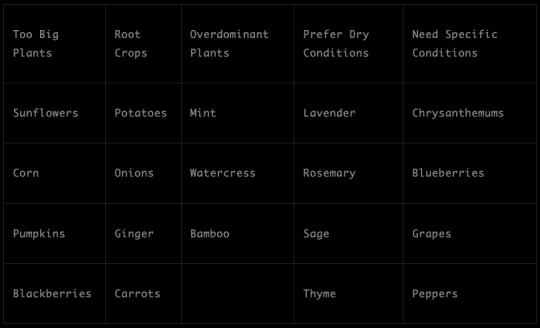
overdominant and unfit plants for aquaponics
Even though those plants usually don’t grow well in an aquaponics system, there are ways to make it work for almost any plants by playing with factors like grow medium, water timing, and nutrition composition for the plants.
Disadvantages of Aquaponics
Aquaponics may require a substantial upfront investment and limit the variety of fish that can be grown. Electricity is also needed for components such as heaters and lighting. Plus, certain crops are seasonal which reduces diversity and availability in certain regions.
In spite of its advantages, aquaponics can be difficult to set up and requires some basic knowledge to maintain. Prospective farmers must assess their resources, skills, and goals to see if it's suitable.
Don't miss out on this! Aquaponics can revolutionize farming while being eco-friendly and self-sustaining. Embrace the future of agriculture at your home now!
Ready to explore the cost of aquaponics? Get your calculator and fish jokes ready - make sustainability profitable!
Cost Analysis of Setting Up Aquaponics
We all love numbers so here you go. Conducting the cost analysis for an aquaponics system is key to understanding the investment necessary for long-term profits. Analyzing the expenses and their ROI allows one to gauge the financial feasibility of this sustainable farming method.
A table below shows the cost analysis of setting up aquaponics:

cost analysis of setting up aquaponics
This detailed breakdown lists the components and associated costs for aquaponics setup. It includes fish tanks, grow beds, plumbing, pumps, lighting, seeds, and fish. The initial investment for these items = $1,610.
Also, operational costs such as feed, electricity, water, maintenance, and labor must be taken into account. These regular expenses help maximize profits and ensure the system works well.
Pro Tip: When calculating aquaponics setup costs, assess the quality of the equipment carefully. High-quality components may cost more initially, but can lead to higher ROI in the long run because of less failure. If you are on a tight budget I would heavily advise you to buy second hand and give old items a new life. Especially fish tanks and fish can be bought for a fraction of the new price, sometimes even for free from places like facebook marketplaces or craigslist.
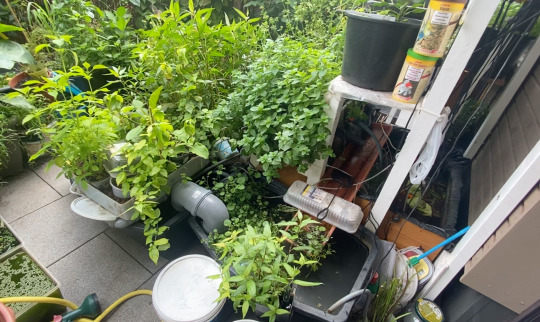
Automated aquaponics system with multiple connected container one month later
Profitability Explained
By analyzing the financials, one can understand the profitability of aquaponics. This sustainable farming system combines aquaculture and hydroponics. Therefore, it uses resources efficiently, reducing costs and maximizing yields for you and the planet.
Investment Costs: $1,610 for initial setup.
Operating Costs: $500 per month for labor and maintenance equals $6000 per year. I have calculated very generously because fish feeders and automated filter beds do almost all the work and the main expense: fish feed can partially be replaced with feeding leftovers, upcycling organic waste with black soldier fly larvae and growing algae for omega 3.
Revenue Generation: $9,000 per year through chemical free produce.
The price you would pay for truly organic fish and plants can’t be measured but lets calculate with regular food prices.
So let's say you have an IBC Tank with 275 Gallon, want to maximize your profit and do everything right.
A german breeder gave me numbers of 200 kg(440 pounds) of catfish per 1000 liters(264 gallon) per year.
440 pounds of catfish = $4400 at a price of $10 per pound
Calculating the plants is a little tricky. Depending on what you grow the amounts of harvest but also the price can vary massively.
For maximum profit growing cannabis can return your investment after the first harvest (but cannabis doesn’t work with catfish).
Herbs grow very well with catfish because the carnivore diet is rich in nitrogen which is great for leaf growth.
Per year you should be able to at least grow 50 pounds of different herbs. For simplicity let's calculate with mint.
0.5 oz of Mint cost $2.99.
0.5 oz = 0.03125 lbs
50 lbs / 0.03125 lbs = 1600 * $2.99 = $4784
Real World Math
Unfortunately the real world doesn’t work like that. Fish keeping and caring for plants is a journey that you and your fish go together hand in hand. As the fish grow and eat more, the bacteria that transform harmful ammonia into safe nitrate, grow with them as well as the plants. Once this complex ecosystem is established and you’ve gained more experience over time you can expect those numbers that I’ve calculated with. Nevertheless you can expect a return on investment in 1 to 2 years.
The closed-loop system reduces environmental impacts, conserves water and eliminates the need for fertilizers or pesticides. It supports local biodiversity and addresses the issue of overfishing.
The FAO conducted a study, which reveals 90% of marine fish stocks are either fully exploited or overexploited. This necessitates alternative solutions, such as aquaponics. Aquaponics is where fish and vegetables learn to coexist, forming a delicious ecosystem and we are part of it.
Benefits of Aquaponics
Aquaponics is an innovative circular system that offers many advantages. It eliminates water waste by using the nutrient-rich water from fish tanks to fertilize plants. This makes it more efficient and sustainable. It can be adapted to individual needs, reducing the need for chemicals, single use plastic and transportation costs. Plus, it allows for local production and year-round cultivation.
There's a success story of a small-scale farmer who established an aquaponic system in their backyard. This enabled them to grow their own food sustainably while generating a surplus to sell locally. Not only did they enjoy fresh produce, mental and physical wellbeing, but they also experienced economic and environmental benefits. Insects and birds started visiting their backyard more frequently. From bees to hummingbirds the sheer amount of variety made exploring nature fun again.
Safe or Not for My Children and Me?
Aquaponics: Secure & Healthy for You & Kids!
Be assured: aquaponics is a safe way to get fish and veg for you and your little ones. Its closed-loop system gives plants nutrients from fish poo, reducing contamination risks.
This mix of aquaculture & hydroponics ensures no harmful chemicals are used like antibiotics or pesticides, making it a healthy choice. The controlled environment also minimizes water contamination, keeping you & your family safe. Another factor is the health benefits of cleaning and humidifying the air by plants. This can be very important in air polluted cities. Smog, exhaust fumes and carbon monoxide are filtered and exchanged for life essential oxygen. Further they can replace electricity intensive air conditioning in places like India or Thailand year round just by turning the sunlight into food and releasing water vapor into the air.
Plus, aquaponics promotes sustainable farming, eliminating overfishing worries. By cultivating fish in a controlled system, it reduces the need to capture fish from the wild with lots of unwanted bycatch like whales, dolphins or sea turtles, helping them survive in their natural habitats.
To make sure your aquaponic system is safe for your fam, there are a few tips. Regularly check water quality, like strange smell or fast breathing fish, to keep conditions optimal for plants & fish. Plus, maintain equipment & clean often to reduce any risks.
By following these pointers, you can enjoy aquaponics' eco-friendly & safe food production, while nourishing your family with fresh & healthy fish & veg!
Health and Aquaponics at Home
Health and aquaponics go hand in hand. When you have an aquaponics system in your home, you can grow fresh produce without chemicals or pesticides.
Here are some of the health benefits associated with home aquaponic systems:
Fresh, Nutrient-Rich Produce: Aquaponics allows you to grow fresh fruits, vegetables, and herbs year-round, providing a consistent source of nutrient-rich produce that is free from harmful pesticides and fertilizers.
Antibiotic-Free Fish: Raising fish in a controlled environment reduces the risk of disease, eliminating the need for antibiotics and other chemicals. This results in healthier, antibiotic-free fish for consumption.
Air Purification: Plants grown in aquaponic systems release oxygen and absorb carbon dioxide, contributing to cleaner and fresher indoor air. They also have the ability to filter and purify the air by removing volatile organic compounds (VOCs) and other pollutants.
Increased Humidity: The evaporation of water from the aquaponic system can increase indoor humidity levels, which can be beneficial for respiratory health, skin hydration, and overall comfort, especially in dry climates or during winter months.
Reduced Risk of Contaminated Produce: Growing your own produce reduces the risk of exposure to contaminated fruits and vegetables, which can sometimes occur in commercially grown products due to pesticide residues or bacterial contamination.
Educational Value: Aquaponic systems offer educational opportunities for learning about ecosystems, plant growth, fish biology, and sustainable agriculture, fostering a greater understanding of food production and environmental stewardship.
Promotes Healthy Eating: Having access to fresh produce and fish at home encourages healthier eating habits, promoting a balanced and nutritious diet.
Sustainable and Eco-Friendly: Aquaponic systems use less water and land compared to traditional farming methods, contributing to sustainable food production and reducing the environmental footprint.
Mental Wellbeing: Engaging with aquaponic systems can have therapeutic effects, reducing stress, promoting relaxation, and improving mental wellbeing. The presence of water and greenery can create a calming environment.
Sustainability of aquaponics: Feeding fish with plants, then the plants may end up as sushi! Crazy, right?
Sustainability of Aquaponics
Aquaponics: A Sustainable Combination of Aquaculture and Hydroponics.
This method recycles water from fish tanks, utilizes grey water to nourish plants, minimizes food waste by refeeding leftovers, enables individuals to produce food at home sustainably, reduces the need for agricultural land and deforestation, and provides a cost-effective protein source.
Knowing that you actively fight climate change can give you great purpose:
Waste Repurposing: Aquaponic systems are excellent at turning waste into resources. Leftover food and organic kitchen waste can be introduced into the system as feed for fish and worms, contributing to a reduction in household waste and promoting a circular economy.
No Microplastic Contamination: By growing your own produce and fish, you avoid the risk of microplastic contamination that can occur with commercially grown products due to the prevalence of single-use plastics in packaging and agricultural processes.
Supporting Biodiversity at Home: Aquaponic systems create a balanced ecosystem within your home, supporting a variety of life including fish, plants, bacteria, and insects. This diversity contributes to the resilience and productivity of the system.
Contributing to Wild Biodiversity: By relying less on commercially farmed produce and overfished stocks, you help reduce the pressure on natural ecosystems and contribute to the conservation of biodiversity in the wild.
Reduced Use of Single-Use Plastics: Growing food at home reduces dependence on store-bought products that often come packaged in single-use plastics. This contributes to a reduction in plastic waste and helps prevent environmental contamination.
Reduced Food Miles: Growing food at home reduces the need for transportation, lowering carbon emissions and ensuring fresher and more flavorful produce.
No Synthetic Fertilizer and other Chemicals: Growing at home gives you a unique opportunity to have full transparency over your produce. This way you can ensure no harmful chemicals are used and no GMO is present.
Originating from ancient cultures, such as the Aztecs and Chinese, modern aquaponics combines technology with nature. Due to its eco-friendly approach and ability to address overfishing and land scarcity it is one of the most promising steps to become sustainable as individuals.
Do you want to start your own aquaponics system at home? Click on this step-by-step guide.
Short Summary
Aquaponics is a sustainable method of raising both fish and vegetables. It's a form of agriculture that combines raising fish in tanks (aquaculture) with soilless plant culture (hydroponics). In aquaponics, the nutrient-rich water from the fish tanks provides a natural fertilizer for the plants, which in turn help to purify the water in which the fish live.
The core of an aquaponics system is the aquaponics fish tank. Common fish used in aquaponics include tilapia, trout, catfish, and salmon, with tilapia being one of the most popular due to its resilience. Some adventurous practitioners even raise crawfish and shrimp! The choice of fish can depend on the local climate, regulations, and the system's goals, whether for consumption or ornamental purposes.
Water from the fish tank is pumped into plant growing areas, where plants uptake the nutrients. The types of plants that thrive in these systems range widely. Lettuce, herbs, and other leafy greens are especially common, but with the right setup, you can grow a variety of vegetables and even fruits. Some enthusiasts also experiment with vertical aquaponics or deep water culture variations to maximize their yield in small spaces.
Aquaponics setups can range from small DIY aquaponics systems, like mason jar aquaponics or mini aquaponics, to large commercial operations. One popular DIY method involves using IBC totes. Larger setups might be housed in specialized aquaponics greenhouses.
Comparing aquaponics vs hydroponics, the primary difference is the presence of fish. Hydroponics relies on added nutrients without the presence of fish. Another variant, aeroponics, mists the roots of the plants with nutrient-rich water. Each method has its pros and cons, but all aim to optimize growth conditions for plants.
There are various components to consider in an aquaponics system, from the type of grow media used to the water pumps, filters, and bell siphons that help regulate water flow. Designing an efficient system is crucial, whether you're aiming for a backyard aquaponics setup or a commercial-scale operation.
For beginners looking to delve into aquaponics, several starter kits and courses, like the aquaponics design course, provide step-by-step instructions. There are also numerous resources, such as books and forums, where enthusiasts share their designs, like the media bed aquaponics or the NFT (Nutrient Film Technique) aquaponics.
In summary, aquaponics is a promising, sustainable farming method that combines aquaculture and hydroponics. It offers benefits like reduced water usage and eliminates the need for chemical fertilizers, making it an eco-friendly option for modern agriculture.
Frequently Asked Questions (FAQs)
What is aquaponics? Aquaponics is a sustainable agriculture system that combines traditional aquaculture (raising aquatic animals) with hydroponics (cultivating plants in water) in a symbiotic environment.
How to set up an aquaponics system / How to build an aquaponics system? Setting up an aquaponics system involves preparing a fish tank, connecting it to plant grow beds, ensuring proper water circulation, and establishing a beneficial bacterial colony to convert fish waste into plant nutrients.
How to build an aquaponics greenhouse? An aquaponics greenhouse is a controlled environment that houses the aquaponics system. It involves constructing a transparent structure, ensuring temperature control, and setting up the aquaponics system inside to benefit from the controlled conditions.
How aquaponics works / How does aquaponics work / How does an aquaponics system work? Fish produce waste, which contains ammonia. Beneficial bacteria convert this ammonia into nitrates, which plants use as nutrients. As plants absorb these nutrients, they also clean the water, which is then recirculated back to the fish tank.
Where to buy fish for aquaponics? / Where to buy fish for aquaponics system? / Where to buy fish for aquaponics near me? Fish for aquaponics can be purchased from local fish hatcheries, specialized aquaponics suppliers, or reputable online vendors.
What role do bacteria play in an aquaponics system? Beneficial bacteria are crucial in converting ammonia from fish waste into nitrates, which plants can absorb as nutrients.
What is the difference between hydroponics and aquaponics? Hydroponics is a method of growing plants in a nutrient-rich water solution without soil, while aquaponics combines aquaculture and hydroponics, using fish waste as a natural nutrient source for plants.
What can you grow with aquaponics? A variety of plants can be grown, from leafy greens like lettuce and herbs to larger plants like tomatoes, cucumbers, and even fruit trees, depending on the system's size.
What is the best fish for aquaponics / What fish are best for aquaponics / What are the best fish for aquaponics? Tilapia, catfish, and trout are commonly used because of their hardiness and growth rate. The choice often depends on local regulations and climate.
Why is aquaponics important? Aquaponics is a sustainable and efficient method of food production, using less water than traditional agriculture and eliminating the need for synthetic fertilizers.
How to lower pH in aquaponics system / How to lower pH in aquaponics? pH can be lowered using natural methods like adding peat moss or certain organic acids. Monitoring and adjusting pH gradually is crucial.
How to make a bell siphon for aquaponics? A bell siphon is a self-regulating siphon mechanism for flood and drain systems. It involves an outer bell, an inner standpipe, and a media guard to ensure consistent water drainage.
How much does an aquaponics system cost? The cost varies depending on the system's size, materials used, and whether it's DIY or commercially purchased. Small DIY setups can start as low as $50, while larger commercial systems can run into thousands of dollars.
What to feed tilapia in aquaponics? Tilapia can be fed pellet fish food designed for them, supplemented with leafy greens or algae. Worms and black soldier fly larvae offer healthy protein and fats and can be bred at home.
Aquaponics how to build / How to start aquaponics / Aquaponics how to / How to do aquaponics / How to construct an aquaponics system pdf / How to set up aquaponics? Begin with understanding the space and resources available. Decide on the location, grow bed type, and what fish and plants you want to grow. Set up the fish tank, connect it to the grow beds, ensure proper water circulation, introduce fish, and then introduce plants.
How to make an aquaponics system / How to make a aquaponics system? Building an aquaponics system involves setting up a fish tank, creating grow beds (either floating or media-based), ensuring a water pump and filtration system, and establishing a healthy microbial community to aid in nutrient conversion.
#sustainability#plasticfree#environment#wastefree#trash#viral#sustainable#food waste#water#aquaponics
3 notes
·
View notes